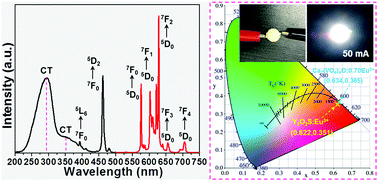Facile preparation of Eu3+-activated Ca7(VO4)4O nanoparticles: a blue light-triggered red-emitting platform for indoor solid-state lighting
Abstract
Using the sol–gel technique, Ca7(VO4)4O nanoparticles with various doping concentrations of Eu3+ ions were achieved. With an excitation wavelength of 462 nm, the as-synthesized compounds can emit visible red light, which exhibited a high color purity of 82.8%, arising from the 4f–4f transitions of Eu3+ ions. The emission intensity of the Eu3+ ions in the Ca7(VO4)4O host lattices was sensitive to the dopant content with an optimum value of 10 mol%. The critical distance for the Eu3+ ions in the Ca7(VO4)4O host lattices was 32.64 Å, and dipole–dipole interactions resulted in the concentration quenching effect. By employing the Judd–Ofelt theory, the optical transition intensity parameters of the Eu3+ ions were calculated and the values of Ω2 and Ω4 were determined to be 2.81 × 10−20 cm−2 and 0.54 × 10−20 cm−2, respectively. The thermal stability of the resultant nanoparticles was verified by the temperature-dependent emission spectra, and the activation energy was determined to be around 0.47 eV. Additionally, the developed light-emitting diode device, which contained a blue chip, commercial Y3Al5O12:Ce3+ yellow-emitting phosphor and the prepared nanoparticles could emit visible white light with satisfactory colorific behavior; it had a proper color rendering index (76.5) and a low correlated color temperature (5435 K).



 Please wait while we load your content...
Please wait while we load your content...